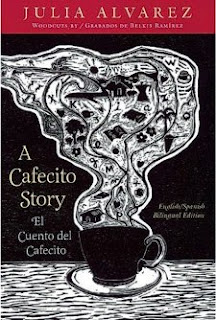Alvarez, Julia. A Cafecito Story. White River Junction, VT: Chelsea Green Publishing Company, 2001.
Julia Alvarez's book, A Cafecito Story, is both engaging and very informational in only 37 pages, not including the afterword. The story follows the life of Joe as he grows up on a farm in Nebraska, takes a vacation from a teaching job to the Dominican Republic, and ends up staying in Manabao to begin growing coffee in a cooperativo. His connection in Manabao is a family he meets while on vacation, who is fighting to keep their traditional, environmentally-friendly way of growing coffee alive instead of caving in to a major company that uses pesticides and unnatural methods of growing the beans. While they teach him how to grow and harvest coffee beans, Joe teaches them to read and write. They unite other farmers from around the area into a cooperative so that they are more sustainable, profitable, and powerful within the market. The major themes throughout the story include individuality and community versus large corporations, the importance of quality over quantity in the things (or coffee) in one's life, and the incredible strength in creativity and perseverance. Furthermore, the juxtaposition of life on a farm-cooperativo in the Dominican Republic versus a large town in the United States is interesting, and could be relatable to students who have moved from dissimilar areas in their life.
The story has a few flaws for teaching in a middle school: the protagonist is mostly an adult throughout the novel, which may not be as engaging for students than a book about an adolescent would be (yet on the other hand, it could make it more interesting), it focuses on coffee (which students this young might not have an interest in), and it is very short with many illustrations throughout. The unique plot of the story and its major themes, however, definitely make this story worth reading, and it's combination of English and Spanish words would be useful for bilingual students or for cross-curricular teaching with a Spanish classroom. At the very least, I would suggest having this book available as an independent reading book for students in middle school grades because it empowers the reader to think globally and still believe in the power of individual action.

No comments:
Post a Comment